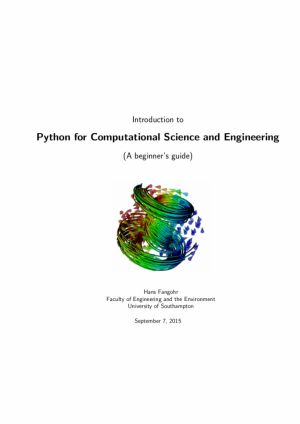Introduction to Python for Computational Science and Engineering
A beginner's guide
by Hans Fangohr
DescriptionTable of ContentsDetailsHashtagsReport an issue 





Book Description
This book summarises a number of core ideas relevant to Computational Engineering and Scientific Computing using Python. The emphasis is on introducing some basic Python (programming) concepts that are relevant for numerical algorithms. The later chapters touch upon numerical libraries such as numpy and scipy each of which deserves much more space than provided here. We aim to enable the reader to learn independently how to use other functionality of these libraries using the available documentation (online and through the packages itself).This open book is out of copyright. You can download Introduction to Python for Computational Science and Engineering ebook for free in PDF format (2.9 MB).
Table of Contents
Chapter 1
Introduction
Chapter 2
A powerful calculator
Chapter 3
Data Types and Data Structures
Chapter 4
Introspection
Chapter 5
Input and Output
Chapter 6
Control Flow
Chapter 7
Functions and modules
Chapter 8
Functional tools
Chapter 9
Common tasks
Chapter 10
From Matlab to Python
Chapter 11
Python shells
Chapter 12
Symbolic computation
Chapter 13
Numerical Computation
Chapter 14
Numerical Python (numpy): arrays
Chapter 15
Visualising Data
Chapter 16
Numerical Methods using Python (scipy)
Chapter 17
Where to go from here?
Book Details
Title
Introduction to Python for Computational Science and Engineering
Subject
Computer Science
Publisher
Self-publishing
Published
2015
Pages
167
Edition
1
Language
English
PDF Size
2.9 MB
License
Out of Copyright
Related Books
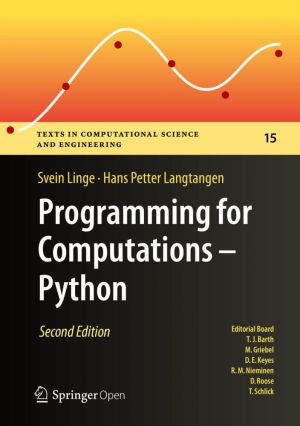
This book presents computer programming as a key method for solving mathematical problems. This second edition of the well-received book has been extensively revised: All code is now written in Python version 3.6 (no longer version 2.7). In addition, the two first chapters of the previous edition have been extended and split up into five new chapte...
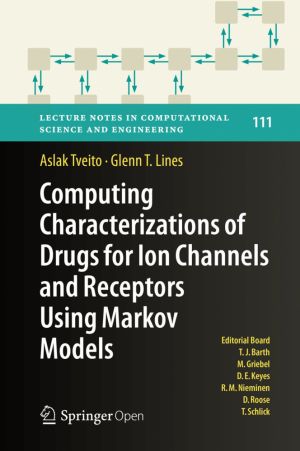
Flow of ions through voltage gated channels can be represented theoretically using stochastic differential equations where the gating mechanism is represented by a Markov model. The flow through a channel can be manipulated using various drugs, and the effect of a given drug can be reflected by changing the Markov model. These lecture notes provide...
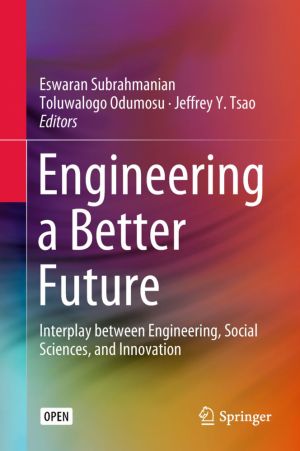
This book examines how the social sciences can be integrated into the praxis of engineering and science, presenting unique perspectives on the interplay between engineering and social science. Motivated by the report by the Commission on Humanities and Social Sciences of the American Association of Arts and Sciences, which emphasizes the importance...

This book focuses on nuclear engineering education in the post-Fukushima era. It was edited by the organizers of the summer school held in August 2011 in University of California, Berkeley, as part of a collaborative program between the University of Tokyo and UC Berkeley. Motivated by the particular relevance and importance of social-scientific ap...
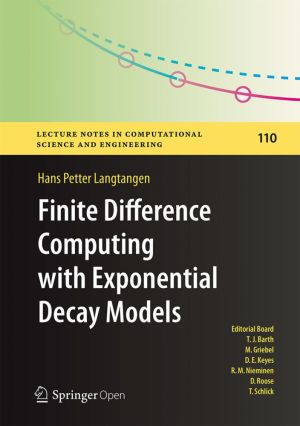
This text provides a very simple, initial introduction to the complete scientific computing pipeline: models, discretization, algorithms, programming, verification, and visualization. The pedagogical strategy is to use one case study – an ordinary differential equation describing exponential decay processes – to illustrate fundamental concepts ...
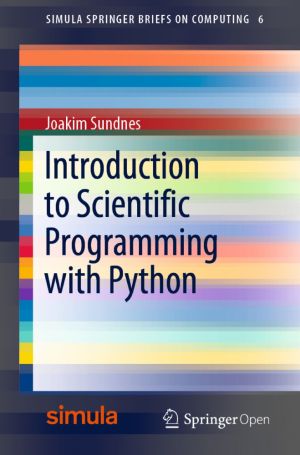
This open book offers an initial introduction to programming for scientific and computational applications using the Python programming language. The presentation style is compact and example-based, making it suitable for students and researchers with little or no prior experience in programming.
The book uses relevant examples from mathematics a...

